New E-Petition Demands Government To Provide Defibrillators In All Public Buildings
Should you be one of the 30,000 to suffer cardiac arrest away from a hospital each year, your chances of survival are as high as 75 per cent should defibrillation be delivered rapidly, according to The British Heart Foundation. They say that at least 230 lives that have been saved already by members of the public and emergency services using portable defibrillators.
From the moment you stop breathing, it takes four minutes before your brain starts to die. Applying a controlled shock within five minutes of collapse provides the best chance of survival. For every minute your heart is stopped, the chances of staying alive are reduced by 14 per cent.
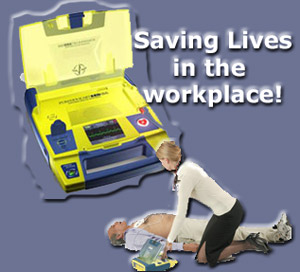 But in the workplace, USRs and First Aiders know that even more deaths can be prevented if a defibrillator is available in the event of a sudden cardiac arrest, as a result of an incident at work, be it due to an accident or that of a case of SAD.
But in the workplace, USRs and First Aiders know that even more deaths can be prevented if a defibrillator is available in the event of a sudden cardiac arrest, as a result of an incident at work, be it due to an accident or that of a case of SAD.
Sudden Arrhythmic Death Syndrome (SADS) results in the heart stopping without warning, and in the majority of cases, results in the death of the person suffering such a cardiac arrest attack. This can as easily happen due to an undiagnosed health condition as it can following major trauma being sustained due to an accident at work.
There is no current medical test that can detect a health condition existing in a person that would make SAD a high risk for an individual. The only certainty is that it occurs in people that are totally well and have no history of heart complaints, as well as those with existing and identified heart conditions. It can occur in people from the age of 12 right up to the age of 35.
So should the law be changed in order to make it compulsory for all employers to have one available and their employees trained in using one? Chris Ingram, web Editor of Unionsafety certainly thinks so:
"We are going to see more and more preventable deaths in the workplace as a result of the Coalition Government's attacks on Health and Safety legislation, and the 77% cut in visits by enforcement authorities, the HSE and local government Environmental Health personnel; as a result of budget cuts and government dictate.
If we are to prevent what now occurs in the USA, deaths by neglect as employers fail to implement legal requirements in health and safety protection, with impunity; knowing as they do that no enforcement authority inspections will ever take place, full first aid provision and training along with the use of portable defibrillators will be a major tool in the employer's and their USRs defense arsenal."
 He concluded:
He concluded:
"There is more chance of my going to the Moon than there is of employers en-masse voluntarily providing portable defibrillators in the workplace; and so the only way forward will be legislation making it compulsory for employers to do so."
The media has recently reported on several high profile cases, usually involving a sports person or celebrity; placing the occurrence of SADS in the public eye, naming the condition as Sudden Adult Death Syndrome.
One such case was that of Oliver King, a 12 year old who died following a sudden and without warning cardiac arrest. The conclusion provided by the media was that he had died of sudden adult death syndrome.
Previously, A body called The Resuscitation Council (UK) was formed in August 1981 by a group of medical practitioners from a variety of specialties who shared an interest in, and concern for, the subject of resuscitation.
The objective of the Council was, and still is, to facilitate education of both lay and healthcare professional members of the population in the most effective methods of resuscitation appropriate to their needs.
A joint statement by The British Heart Foundation and The Resuscitation Council issued in 2010 said:
“A key component in the success of national schemes has been the wide availability for lay use of automated external defibrillators (AEDs) that deliver a shock to reverse ventricular fibrillation (the most common form of cardiac arrest) and thus allow effective cardiac rhythm to be re-established.
This is most likely to be successful when given very soon after the onset. Optimal conditions for defibrillation are present for only 1-2 minutes with success rates decreasing thereafter by at least 10% per minute of delay.
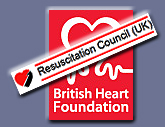 AEDs can be used safely even by untrained lay people who witness an arrest or who are nearby and can respond more quickly than the ambulance service. The minutes saved are crucial and the strategy has been responsible for saving many lives.”
AEDs can be used safely even by untrained lay people who witness an arrest or who are nearby and can respond more quickly than the ambulance service. The minutes saved are crucial and the strategy has been responsible for saving many lives.”
The Council have produced a guideline document aimed at explaining in basic terms the method used to save lives through what is commonly known as CPR (Cardiopulmonary Resuscitation). The document also provides detail of the best way of delivering CPR, checking if the person concerned actually needs CPR, and the duration of the ‘chest compressions’ required.
It is important to remember that the priority is to ensure good-quality CPR with minimal interruption, and early defibrillation when appropriate.
Whilst the distribution of defibrillators for use by members of the public in the event of someone suffering a sudden cardiac arrest, has been a success to the extent where such machines have been provided, the fact is that many automated defibrillators (AEDs) are being placed in locked cabinets, a strategy currently adopted by some organisations. A potential operator must have a key or has to phone to obtain a code to unlock the cabinet and gain access to the AED, a process that can take several minutes.
Given the importance of reducing to a minimum the time taken to administer a shock, we believe that no delays or constraints should be placed on any person willing to use an AED nor should there be any physical barrier to restrict the immediate use of an AED such as a locked and / or coded cabinet.
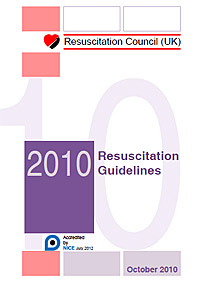 In a joint statement by the Resuscitation Council and the British Heart Foundation commented on this issue:
In a joint statement by the Resuscitation Council and the British Heart Foundation commented on this issue:
“We appreciate the desire for equipment security. But there has been minimal vandalism or theft in the National Defibrillator Programme in which AEDs are located in cabinets that are not locked but fitted with alarms that are activated when the cabinets are opened. We believe this strategy could easily be adopted by any AED project. Moreover the devices do not pose any threat to the safety of users or victims.
To reinforce the importance of this policy, no BHF resources will be allocated to strategies that place AEDs in locked cabinets, either in relation to equipment itself or through the work of the healthcare professionals that are funded by the BHF.”
The National Defibrillator Programme, which was coordinated by the Department of Health from 2000, began placing automated external defibrillators in public places. From February 2007, responsibility for continuing the work of the National Defibrillator Programme was devolved to NHS ambulance trusts.
Following the sudden death of 12 year old Oliver King from Sudden Arrhythmic Death Syndrome, a foundation named after him was formed, and one of their first aims is for the Government to ensure that defibrillators that can be used by any person willing to do so, are provided in all public buildings by 2017.
Their E-petition to the government simply says:
“We call on the Government to introduce defibrillators to all public buildings by 2017, and provide staff with the appropriate training. We also call on the Government to offer all people aged between 12 & 35 a simple ECG test, which could reduce the current death rate of 12 young people a week.”
It also refers to screening for SAD through the use of the national screening programme for hypertrophic cardiomyopathy, which is one of the courses of SAD. But, in a response to the petition having reached 100,000 signatures (110,000 at time of writing), the Government said:
"The UK National Screening Committee (UK NSC) advises ministers and the NHS in all four UK countries about all aspects of screening policy. It recommended in 2008 that a national screening programme for hypertrophic cardiomyopathy (HCM), an important cause of sudden death in those under thirty, should not be introduced, as sudden cardiac death can be caused by a range of conditions, many of which are difficult to detect through screening."
It goes on to say:
"In line with its three yearly review policy, the UK NSC is currently reviewing its policy position on screening for HCM once again. The review will take into account the most up-to-date international evidence and there will be an opportunity for the public to participate in the review process next year when a copy of the completed HCM review will be open for public consultation on the UK NSC’s website at www.screening.nhs.uk"
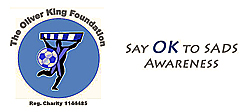 Using a defibrillator is not rocket science and anyone feeling confident enough can use one. A defibrillator uses electricity to shock the heart out of this lethal rhythm and back to normal.
Using a defibrillator is not rocket science and anyone feeling confident enough can use one. A defibrillator uses electricity to shock the heart out of this lethal rhythm and back to normal.
“It's important to remember that you cannot kill someone with a defibrillator.” says Clive James, a St John Ambulance trainer.
"The AED automatically carries out many of the key stages of resuscitation, such as recognising the electrocardiogram rhythm (ECG). This assesses whether the heart is shockable." says Clive James, "In 80 per cent of cases it will be."
The Oliver King Foundation, in conjunction with Liverpool City Council, will be placing a defibrillator in every primary school in Liverpool. The four schools that have had their defibrillators fitted so far are: Childwall C. of E. Primary School, Kensington Community Primary School, Our Lady of Good Help Primary School, and Springwood Heath Primary School.
Meanwhile in Germany, the Federal State of Berlin 4 years ago equipped all of their Doctor’s Ambulance vehicles and the Fire Brigade Training Centre in the City of Berlin with AutoPulse Non-invasive Cardiac Support Pumps. The German capital, with around 3.3 million citizens, is the largest city in Germany and also has the country’s largest fire brigade.
Michael Toursarkissian, M.D., a Director of the Working Committee of EMS Physicians Berlin and Senior Physician for Anaesthesia and ICU at Red Cross Hospital Berlin, recommended the purchase following successful use and a number of saved lives after two years of trialling the device.
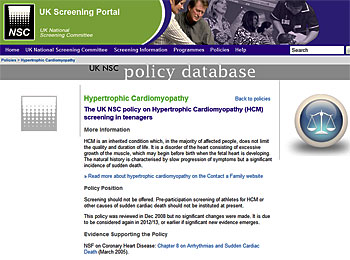 AutoPulse helps provide the consistent, uninterrupted chest compressions called for by the 2005 American Heart Association and European Resuscitation Council Guidelines.
AutoPulse helps provide the consistent, uninterrupted chest compressions called for by the 2005 American Heart Association and European Resuscitation Council Guidelines.
It is an automated, portable device with an easy-to-use, load-distributing ‘Life Band’ that squeezes a wider area of the chest in a consistent, uninterrupted “hands-free” manner, improving blood flow to the heart and brain during cardiac arrest.
Additionally, it offers the benefit of freeing up rescuers to focus on other life-saving interventions.
Earlier this week, it was announced that automatic defibrillators will be put on every fire engine and at all community fire stations in Merseyside.
Granada News website reported that the Merseyside Fire and Rescue Service says that the AEDs [automated external defibrillator]will be located at the 26 stations and all other fire service buildings across Merseyside for use on staff or members of the public. There will also be a defibrillator on each fire engine.
The defibrillators are being part funded by the British Heart Foundation and Merseyside Fire and Rescue Authority and will be at all the stations and on fire appliances by February 28th.
Source: Zoll Corporation / British Heart Foundation / The Rescusitation Council / Oliver King Foundation / Merseyside Fire And Rescure Service / Unionsafety
See also: How to use a defibrillator on BHF website here
Download the Rescusitation Council Guidelines for using CPR and portable Defibrillators from the E-Library


 But in the workplace, USRs and First Aiders know that even more deaths can be prevented if a defibrillator is available in the event of a sudden cardiac arrest, as a result of an incident at work, be it due to an accident or that of a case of SAD.
But in the workplace, USRs and First Aiders know that even more deaths can be prevented if a defibrillator is available in the event of a sudden cardiac arrest, as a result of an incident at work, be it due to an accident or that of a case of SAD. He concluded:
He concluded: AEDs can be used safely even by untrained lay people who witness an arrest or who are nearby and can respond more quickly than the ambulance service. The minutes saved are crucial and the strategy has been responsible for saving many lives.”
AEDs can be used safely even by untrained lay people who witness an arrest or who are nearby and can respond more quickly than the ambulance service. The minutes saved are crucial and the strategy has been responsible for saving many lives.”

